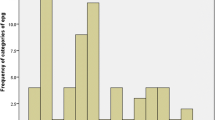Abstract
A cross-sectional study to determine the prevalence and hematological parameters of Fasciola gigantica-infected cattle in Nsukka, Southeastern Nigeria, was carried out between March and May, 2008. Blood samples were collected immediately after slaughter into labeled sample bottles containing EDTA. Characteristics of each slaughtered cattle such as sex and breed were noted. Postmortem examination of the liver, bile ducts, and gall bladder were carried out. Standard techniques were used to determine the packed cell volume (PCV), red blood cell count (RBC), white blood cell count (WBC), and hemoglobin concentration (HbC) while mean corpuscular volume (MCV), mean corpuscular hemoglobin (MCH), and mean corpuscular hemoglobin concentration (MCHC) were calculated appropriately using standard formulae. A total of 200 cattle were examined at postmortem with 23.5% prevalence (95% CI = 0.181–0.299). Fifteen percent (95% CI = 0.107–0.206) of the infected cattle were males while 8.5% (95% CI = 0.054–0.132) were females. White Fulani, Sokoto Gudali, and Red Bororo breeds recorded 20.5% (95% CI = 0.155–0.266), 3% (95% CI = 0.014–0.064), and 0% (95% CI = 0.000–0.019) prevalence respectively. However, no significant association (P ˃ 0.05) exists between Fasciola infections and the breed and sex of sampled animals. The mean PCV, HbC, RBC, and WBC values of the infected cattle were significantly low (P < 0.05) when compared to the uninfected cattle. Public enlightenment on the zoonotic importance of Fasciola gigantica and periodic anthelmintic intervention is hereby recommended.
Similar content being viewed by others
References
Adedokun OA, Ayinmode AB, Fagbemi BO (2008) A comparative study of three methods for detecting Fasciola infections in Nigerian cattle. Veterinarski Arhiv 78:411–416
Akerejola OO, Schillhorn Van Veen TW, Njoku CO (1979) Ovine and caprine diseases in Nigeria: a review of economic loss. Bull Anim Health Prod Afr 27(1):65–69
Aliyu AA, Ajogi IA, Ajanusi OJ, Reuben RC (2014) Epidemiological studies of Fasciola gigantica in cattle in Zaria, Nigeria using coprology and serology. J Public Health 6:85–91
Ardo MB, Aliyara YH, Lawal H (2013) Prevalence of bovine fasciolosis in major abattiors of Adamawa State, Nigeria. Bayero J Pure Appl Sci 6:12–16
Coles EH (1986) Veterinary clinical pathology, 3rd edn. W.B. Saunders Company, Philadelphia, pp 145–151
Egbu FMI, Ubachukwu PO, Okoye IC (2013) Haematological changes due to bovine fascioliasis. Afr J Biotechnol 12:1828–1835
Elelu N, Eisler MC (2017) A review of bovine fasciolosis and other trematode infections in Nigeria. J Helminthol 92:128–141. https://doi.org/10.1017/S0022149X17000402
Ganguly A, Bisla RS, Chaudhri SS (2016) Haematological and biochemical changes in ovine fasciolosis. Haryana Vet 55(1):27–30
Haseeb AN, El Shazly AM, Arafa MAS, Morsy ATA (2002) A review on fascioliasis in Egypt. J Egypt Soc Parasitol 32:317–354
Ikeme MM, Obioha F (1973) Fasciola gigantica infestations in trade cattle in Eastern Nigeria. Bull Epizoot Dis Afr 21:259–264
Lotfy HS, Mahmoud SM, Abdel-Gawad MA (2003) Some studies on fascioliasis in Mid-Egypt. Agric Res 81(2):209–227
Magaji A, Ibrahim K, Salihu MD, Saulawa MA, Mohammed AA, Musawa AI (2014) Prevalence of fascioliasis in cattle slaughtered in Sokoto Metropolitan Abattoir, Sokoto, Nigeria. Advances in Epidemiology Article ID 247258 https://doi.org/10.1155/2014/247258
Mas-Coma S, Brgues MD, Valero MA (2005) Fasciolosis and other plant-borne trematode zoonoses. Int J Parasitol 35(2):1255–1278
McIntyre JD, Bourzat D, Pingel P (1992) Crop-livestock interaction in sub-Saharan Africa. Regional World Bank, Washington D.C
Ngwu GI, Ohaegbula ABO, Okafor FC (2004) Prevalence of Fasciola gigantica, Cysticercus bovis and some other disease conditions of cattle slaughtered in Nsukka urban abattoir. Anim Res Int 1:7–11
Nwosu CO, Madu PP, Richards WS (2007) Prevalence and seasonal changes in the population of gastrointestinal nematodes of small ruminants in the semi-arid zone of north-eastern Nigeria. Vet Parasitol 144:118–124
Osinowo EO, Adama JY, Popoola MA, Shorinmade AY, Afolabi QO (2017) Prevalence of Fasciola gigantica infestation in cattle slaughtered at Minna metropolitan abattoir in North Central Nigeria. J Anim Sci Vet Med 2:160–163
Paul BT, Bello AM, Ngari O, Mana HP, Gadzama MA, Abba A, Malgwi KD, Balami SY, Dauda J, Abdullahi AM (2016) Risk factors of haemoparasites and some haematological parameters of slaughtered trade cattle in Maiduguri, Nigeria. J Vet Med Anim Health 8(8):83–88
Phiri AM, Phiri IK, Sikasunge CS, Monrad J (2005) Prevalence of fasciolosis in Zambian cattle observed at selected abattoirs with emphasis on age, sex and origin. J Veterinary Med Ser B 52:414–416
Urquhart GM, Armour J, Dunn AM, Duncan JL, Jennings FW (1996) Veterinary parasitology, 2nd edn. Blackwell Publishing, Hoboken, pp 209–218
WHO (2007) Report of the WHO informal meeting on use of triclabendazole in fascioliasis control. Tech. Rep. WHO/CDS/NTD/PCT/2007.1
Yadav SK, Ahaduzzaman M, Sarker S, Sayeed MA, Hoque MA (2015) Epidemiological survey of fascioliasis in cattle, buffalo and goat in Mahottari and Dhanusha. Nepal. J Adv Parasitol 2(3):51–56
Funding
No external fund was received for this study. This study was wholly funded by the authors.
Author information
Authors and Affiliations
Corresponding author
Ethics declarations
Conflict of interest
The authors declare that they have no conflict of interest.
Ethical approval
Valid approval and ethical clearance were obtained from the Ethics Committee for Medical and Scientific Research of the University of Nigeria, Nsukka, before the commencement of this study. Also, all applicable international, national, and/or institutional guidelines for the care and use of animals were followed.
Additional information
Publisher’s Note
Springer Nature remains neutral with regard to jurisdictional claims in published maps and institutional affiliations.
Rights and permissions
About this article
Cite this article
Ikenna-Ezeh, N.H., Eke, C., Ezeh, I.O. et al. Prevalence and hematological parameters of Fasciola gigantica-infected cattle in Nsukka, Southeastern Nigeria. Comp Clin Pathol 28, 695–699 (2019). https://doi.org/10.1007/s00580-019-02891-5
Received:
Accepted:
Published:
Issue Date:
DOI: https://doi.org/10.1007/s00580-019-02891-5




